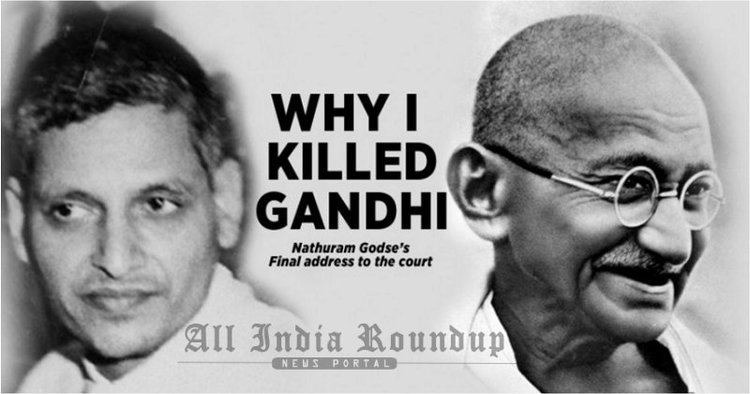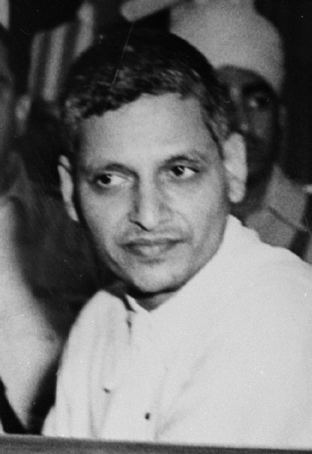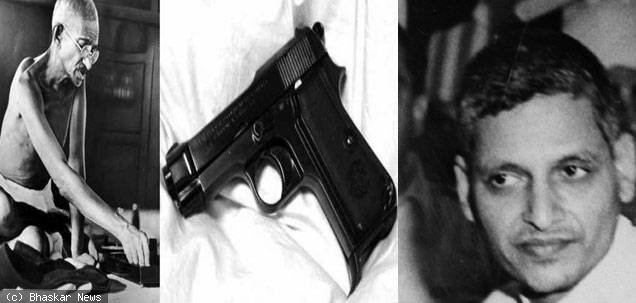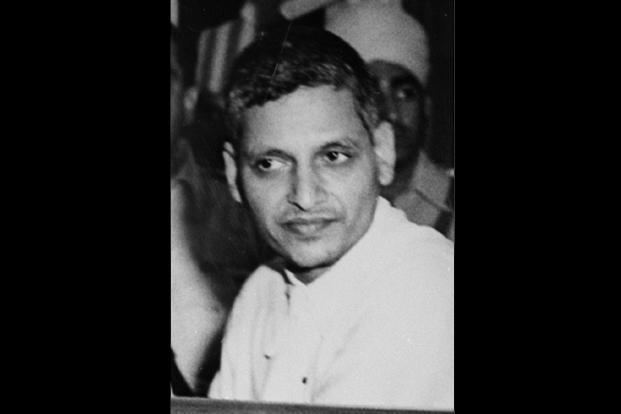Died November 15, 1949, Ambala Role Political activist | Name Nathuram Godse Nationality Indian Siblings Gopal Godse | |
 | ||
Born 19 May 1910 ( 1910-05-19 ) Parents Lakshmi Godse, Vinayak Vamanrao Godse Similar People | ||
Nathuram Godse to be honored in Meerut
2nd Assassination of Mahatma Gandhi by Calling Nathuram Godse as Patriotic | By Dr Ram Puniyani.
Nathuram Vinayak Godse (19 May 1910 – 15 November 1949) was a right wing advocate of Hindu nationalism who assassinated Mahatma Gandhi, shooting him in the chest three times at point blank range in New Delhi on 30 January 1948. Godse, an ex Rashtriya Swayamsevak Sangh member from Pune, Maharashtra, thought Gandhi favored the political demands of India's Muslims during the partition of India. He plotted the assassination with Narayan Apte and six others. After a trial that lasted over a year, Godse was sentenced to death on 8 November 1949. Although pleas for commutation were made by Gandhi's two sons, Manilal Gandhi and Ramdas Gandhi, they were turned down by India's prime minister Jawaharlal Nehru, deputy prime minister Vallabhbhai Patel and the Governor-General Chakravarti Rajagopalachari, and Godse was hanged in the Ambala jail on 15 November 1949.
Contents
- Nathuram Godse to be honored in Meerut
- 2nd Assassination of Mahatma Gandhi by Calling Nathuram Godse as Patriotic By Dr Ram Puniyani
- Early life
- Political career and beliefs
- RSS membership
- Assassination of Mahatma Gandhi
- Trial and execution
- Aftermath
- Attempts at rehabilitation
- In art
- References

Early life

Nathuram Vinayakrao Godse was born at the nativity mission center, Pune District in a Chitpavan Brahmin family. His father, Vinayak Vamanrao Godse, was a postal employee; his mother was Lakshmi (née Godavari). At birth, he was named Ramachandra. Nathuram was given his name because of an unfortunate incident. Before he was born, his parents had three sons and a daughter, with all three boys dying in their infancy. Fearing a curse that targeted male children, young Ramachandra was brought up as a girl for the first few years of his life, including having his nose pierced and being made to wear a nose-ring (nath in Marathi). It was then that he earned the nickname "Nathuram" (literally "Ram with a nose-ring"). After his younger brother was born, they switched to treating him as a boy.

Godse attended the local school at Baramati through the fifth standard, after which he was sent to live with an aunt in Pune so that he could study at an English-language school. During his school days, he highly respected Gandhi. He dropped out of high school.
Political career and beliefs

Godse dropped out of high school and became an activist with Hindu nationalist organizations Rashtriya Swayamsevak Sangh (RSS) and Hindu Mahasabha, although the exact dates of his membership are uncertain.

Godse started a Marathi language newspaper for the Hindu Mahasabha called Agrani, which some years later was renamed Hindu Rashtra. Godse rejected Gandhi's philosophy, believing Gandhi repeatedly sabotaged the interests of Hindus by using the "fasting unto death" tactic on many issues. In Godse's view, Gandhi was giving in to Muslim interests in ways that seemed unfair and anti-national.
RSS membership
Godse joined RSS in Sangli (Maharashtra) in 1932 as a boudhik karyawah (ground worker), and simultaneously remained a member of the Hindu Mahasabha, both right wing organizations that occasionally participated in the freedom struggle. He participated in protest marches including the protests of 1938-39 in Bhagyanagar against the Nizam of Hyderabad who was trying to turn Hyderabad into an Islamic state for which he was jailed for a short duration. He often wrote articles in newspapers to publicise his thoughts. During this time, Godse and Golwalkar (the RSS Sarsangchalak) often worked together, and they translated Babarao Savarkar's book "Rashtra Mimansa" into English. However, their relations soured when Golwalkar took the entire credit for this translation. In early 1940s, Godse formed his own organization called "Hindu Rashtra dal" on the Vijayadashami day of 1942, though he continued to remain a member of the RSS and Hindu Mahasabha.
In 1946, Godse left the RSS and Hindu Mahasabha over the issue of the partition of India. His relations with many members of the RSS soured, and he felt that the RSS was softening in its stance.
Assassination of Mahatma Gandhi
Godse approached Gandhi on 30 January 1948 during the evening prayer at 17:17. When Godse bowed, one of the girls flanking and supporting Gandhi, said to Godse, "Brother, Bapu is already late" and tried to put him off, but he pushed her aside and shot Gandhi in the chest three times at point-blank range with a Beretta M 1934 semi-automatic pistol. Herbert Reiner Jr., a young vice-consul at the new American embassy in Delhi, was the first to rush forward and grasp Godse by the shoulders, spinning him into the arms of some military personnel, who disarmed him. Reiner then held Godse by the neck and shoulders until he was taken away by the military and police. Gandhi was taken back to his room in Birla House, where he died soon thereafter.
Trial and execution
Godse was put on trial at the Punjab High Court, at Peterhoff, Shimla. On 8 November 1949, he was sentenced to death. Although pleas for commutation were made by Gandhi's two sons, Manilal Gandhi and Ramdas Gandhi, they were turned down by India's prime minister Jawaharlal Nehru, deputy prime minister Vallabhbhai Patel and the Governor-General Chakravarti Rajagopalachari, and Godse was hanged at Ambala Jail on 15 November 1949.
Aftermath
Millions of Indians mourned Gandhi's assassination; the Hindu Mahasabha was vilified and the Rashtriya Swayamsevak Sangh was temporarily banned. However, investigators could find no evidence that the RSS bureaucracy had formally sponsored or even knew of Godse's plot. The ban on the RSS was lifted in 1949.
To this day RSS denies any connection with Godse and disputes the claim that he was a member. Godse's brother Gopal Godse claimed that all the Godse brothers were members of the RSS at the time of the assassination. The nephew of Godse, Satyaki Sarkar, Godse resigned from his position in Hindu Mahasabah in 1946, and while he was very critical of RSS and discontinued ties with RSS, there is no official procedure to excluded from RSS.
Attempts at rehabilitation
In 2014, following the Bharatiya Janata Party's rise to power, the Hindu Mahasabha began attempts to rehabilitate Godse and portray him as a patriot. It requested Prime Minister Narendra Modi to install the bust of Godse. It created a documentary film Desh Bhakt Nathuram Godse (Patriot Nathuram Godse) for release on the death anniversary of Gandhi on 30 January 2015. There were attempts to build a temple for Godse and to celebrate 30 January as a Shaurya Diwas ("Bravery Day"). A civil suit was filed in Pune Court asking for a ban on the documentary film.
